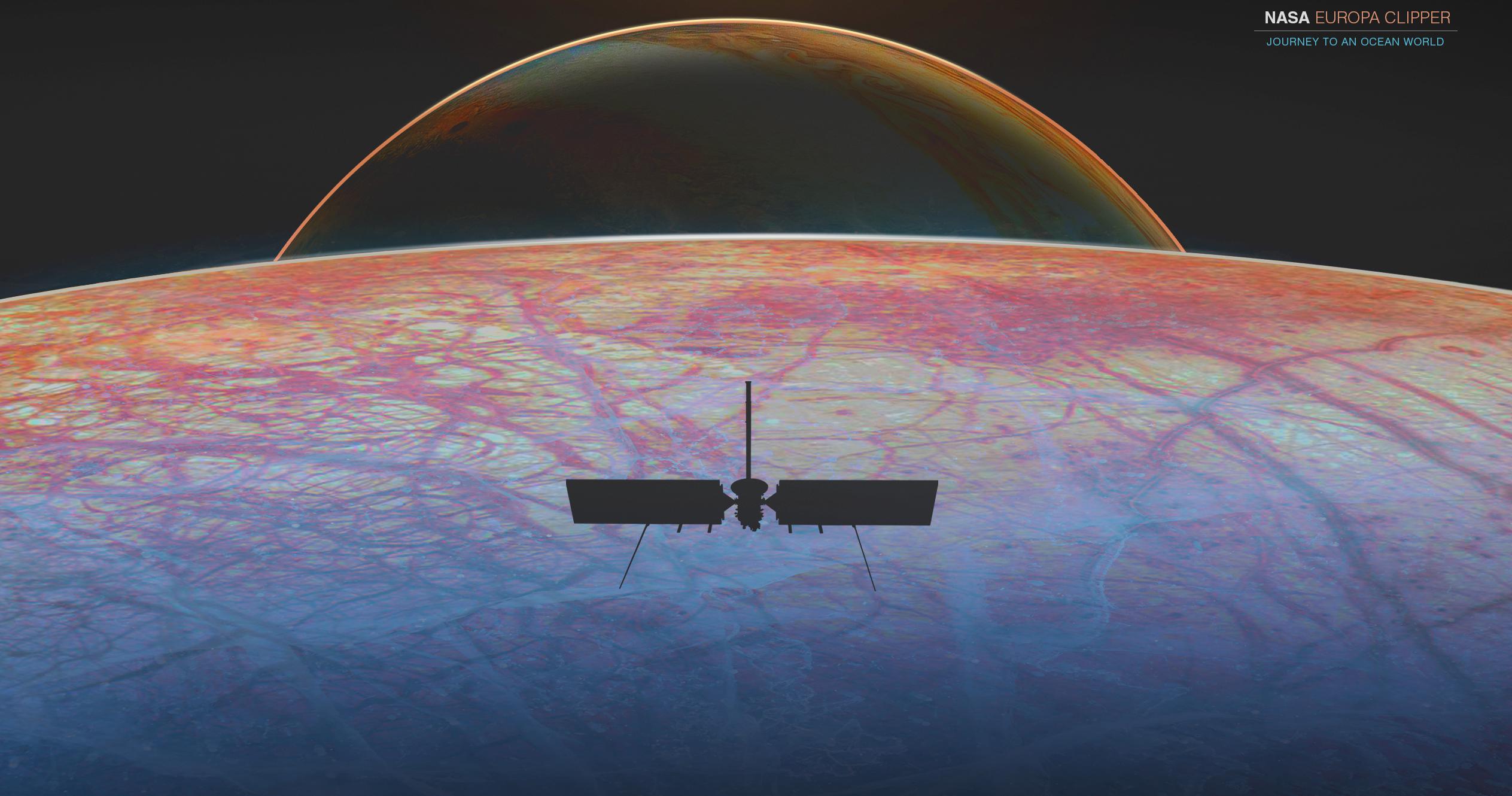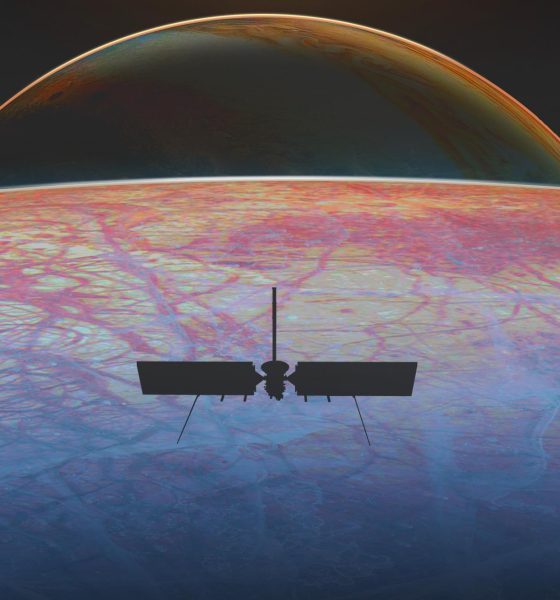

News
SpaceX Falcon Heavy to launch NASA ocean moon explorer, saving the US billions
In a move that’s likely to save the US taxpayer several billion dollars over the next few years, NASA has carefully extricated a mission to one of Jupiter’s ocean moons from the claws of its own Space Launch System (SLS) rocket.
Known as Europa Clipper, the six metric ton (~13,300 lb) spacecraft will instead launch on a SpaceX Falcon Heavy rocket for less than $180M. Had Falcon Heavy not been ready or NASA shied away from the challenge of switching launch vehicles, sending the ~$4.25 billion orbiter to Jupiter could have easily added more than $3 billion to the mission’s total cost. Instead, Europa Clipper will be able to launch one or two years earlier than SLS would have been ready and at a cost that’s practically a rounding error relative to the alternative.
Measuring approximately 3100 km (~1940 mi) in diameter, Europa is approximately 10% smaller and 30% less massive than Earth’s Moon. Both are similar balls of rock with solid metallic cores. However, based on observations taken over decades by spacecraft and Earth-based telescopes, odds are good that Europa also has a vast liquid water ocean insulated by 10-30 km (6-20 mi) of ice so cold that it’s as hard as granite.
Scientists estimate that Europa’s saltwater ocean is dozens to 100+ km (~62 mi) deep, covers the moon’s entire surface, and holds more water than all of Earth’s oceans combined. Signs of a liquid ocean under Europa’s crust (and the crust of numerous other outer solar system moons, as it would turn out) were especially surprising because of the implication that those moons possessed vast heat sources. In the case of Europa, it’s believed that Jupiter’s immense gravitational pull and the moon’s close orbit are balanced in such a way that Europa is heated as those tidal forces violently stretch and squeeze its interior.
In an orbit 30% lower than Europa, tidal heating is so aggressive that the moon Io is littered with titanic volcanoes and lava lakes more than 200 km (~120 mi) across – so large that waves have been spotted on its surface with Earth-based telescopes. In short, because Europa appears to be in the right place to have enough – but not too much – tidal heating, it’s believed to be one of the best potential harbors of extraterrestrial life and Europa Clipper’s primary purpose is to pursue that potential astrobiological treasure trove.
Europa Clipper’s history is a truly bizarre one. Championed almost singlehandedly by fundamentalist Christian and former Republican Representative John Culberson, it’s almost certain that the mission would have never come together and never secured enough funding to proceed. Culberson’s singular goal: determine if humanity is (or is not) alone in the universe. If life can independently evolve twice in the same average solar system, the logic goes, it would practically guarantee that life will be omnipresent anywhere we look.
Culberson’s original vision was an orbiter (Clipper) that would effectively scout Europa for a lander that would follow just a few years later. Incredibly, he appears to have all but guaranteed that Europa Clipper will launch. However, he lost a reelection bid in 2018, casting the lander component into limbo before proper funding or commitments could be ascertained. It now seems likely that the future of Europa Lander will depend almost entirely on what Clipper does (or doesn’t) find.
Europa Clipper is now scheduled to launch on an expendable Falcon Heavy rocket no earlier than a two-week window set to open in October 2024. As part of the politicking to secure the billions of dollars needed to fund the mission, Culberson originally shackled Europa Clipper to NASA’s SLS rocket – now half a decade behind schedule and set to cost more than $23 billion before its first launch. However, it appears that SLS is so mismanaged and uncharacterized that even its infamously zealous, pork-motivated Congressional cheerleaders weren’t willing to put up a public fight to retain the SLS rocket’s only confirmed non-human payload.
Ultimately, on launch alone, Falcon Heavy’s Europa Clipper launch will likely save taxpayers more than $2 billion – the likely minimum cost of a single SLS Cargo launch. Due to issues with the rocket, Ars Technica also reports that Europa Clipper and SLS would have required at least $1 billion in modifications and upgrades to safely fly, meaning that choosing SpaceX will likely end up saving NASA more than $3 billion – equivalent to almost three-quarters of the entire Europa Clipper mission’s price tag.

News
Tesla FSD fleet is nearing 7 billion total miles, including 2.5 billion city miles
As can be seen on Tesla’s official FSD webpage, vehicles equipped with the system have now navigated over 6.99 billion miles.

Tesla’s Full Self-Driving (Supervised) fleet is closing in on almost 7 billion total miles driven, as per data posted by the company on its official FSD webpage.
These figures hint at the massive scale of data fueling Tesla’s rapid FSD improvements, which have been quite notable as of late.
FSD mileage milestones
As can be seen on Tesla’s official FSD webpage, vehicles equipped with the system have now navigated over 6.99 billion miles. Tesla owner and avid FSD tester Whole Mars Catalog also shared a screenshot indicating that from the nearly 7 billion miles traveled by the FSD fleet, more than 2.5 billion miles were driven inside cities.
City miles are particularly valuable for complex urban scenarios like unprotected turns, pedestrian interactions, and traffic lights. This is also the difference-maker for FSD, as only complex solutions, such as Waymo’s self-driving taxis, operate similarly on inner-city streets. And even then, incidents such as the San Francisco blackouts have proven challenging for sensor-rich vehicles like Waymos.
Tesla’s data edge
Tesla has a number of advantages in the autonomous vehicle sector, one of which is the size of its fleet and the number of vehicles training FSD on real-world roads. Tesla’s nearly 7 billion FSD miles then allow the company to roll out updates that make its vehicles behave like they are being driven by experienced drivers, even if they are operating on their own.
So notable are Tesla’s improvements to FSD that NVIDIA Director of Robotics Jim Fan, after experiencing FSD v14, noted that the system is the first AI that passes what he described as a “Physical Turing Test.”
“Despite knowing exactly how robot learning works, I still find it magical watching the steering wheel turn by itself. First it feels surreal, next it becomes routine. Then, like the smartphone, taking it away actively hurts. This is how humanity gets rewired and glued to god-like technologies,” Fan wrote in a post on X.
News
Tesla starts showing how FSD will change lives in Europe
Local officials tested the system on narrow country roads and were impressed by FSD’s smooth, human-like driving, with some calling the service a game-changer for everyday life in areas that are far from urban centers.

Tesla has launched Europe’s first public shuttle service using Full Self-Driving (Supervised) in the rural Eifelkreis Bitburg-Prüm region of Germany, demonstrating how the technology can restore independence and mobility for people who struggle with limited transport options.
Local officials tested the system on narrow country roads and were impressed by FSD’s smooth, human-like driving, with some calling the service a game-changer for everyday life in areas that are far from urban centers.
Officials see real impact on rural residents
Arzfeld Mayor Johannes Kuhl and District Administrator Andreas Kruppert personally tested the Tesla shuttle service. This allowed them to see just how well FSD navigated winding lanes and rural roads confidently. Kruppert said, “Autonomous driving sounds like science fiction to many, but we simply see here that it works totally well in rural regions too.” Kuhl, for his part, also noted that FSD “feels like a very experienced driver.”
The pilot complements the area’s “Citizen Bus” program, which provides on-demand rides for elderly residents who can no longer drive themselves. Tesla Europe shared a video of a demonstration of the service, highlighting how FSD gives people their freedom back, even in places where public transport is not as prevalent.
What the Ministry for Economic Affairs and Transport says
Rhineland-Palatinate’s Minister Daniela Schmitt supported the project, praising the collaboration that made this “first of its kind in Europe” possible. As per the ministry, the rural rollout for the service shows FSD’s potential beyond major cities, and it delivers tangible benefits like grocery runs, doctor visits, and social connections for isolated residents.
“Reliable and flexible mobility is especially vital in rural areas. With the launch of a shuttle service using self-driving vehicles (FSD supervised) by Tesla in the Eifelkreis Bitburg-Prüm, an innovative pilot project is now getting underway that complements local community bus services. It is the first project of its kind in Europe.
“The result is a real gain for rural mobility: greater accessibility, more flexibility and tangible benefits for everyday life. A strong signal for innovation, cooperation and future-oriented mobility beyond urban centers,” the ministry wrote in a LinkedIn post.
News
Tesla China quietly posts Robotaxi-related job listing
Tesla China is currently seeking a Low Voltage Electrical Engineer to work on circuit board design for the company’s autonomous vehicles.

Tesla has posted a new job listing in Shanghai explicitly tied to its Robotaxi program, fueling speculation that the company is preparing to launch its dedicated autonomous ride-hailing service in China.
As noted in the listing, Tesla China is currently seeking a Low Voltage Electrical Engineer to work on circuit board design for the company’s autonomous vehicles.
Robotaxi-specific role
The listing, which was shared on social media platform X by industry watcher @tslaming, suggested that Tesla China is looking to fill the role urgently. The job listing itself specifically mentions that the person hired for the role will be working on the Low Voltage Hardware team, which would design the circuit boards that would serve as the nervous system of the Robotaxi.
Key tasks for the role, as indicated in the job listing, include collaboration with PCB layout, firmware, mechanical, program management, and validation teams, among other responsibilities. The role is based in Shanghai.
China Robotaxi launch
China represents a massive potential market for robotaxis, with its dense urban centers and supportive policies in select cities. Tesla has limited permission to roll out FSD in the country, though despite this, its vehicles have been hailed as among the best in the market when it comes to autonomous features. So far, at least, it appears that China supports Tesla’s FSD and Robotaxi rollout.
This was hinted at in November, when Tesla brought the Cybercab to the 8th China International Import Expo (CIIE) in Shanghai, marking the first time that the autonomous two-seater was brought to the Asia-Pacific region. The vehicle, despite not having a release date in China, received a significant amount of interest among the event’s attendees.








